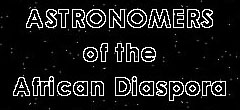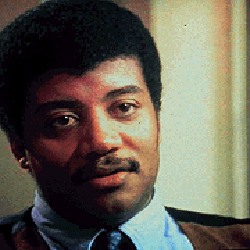


Neil deGrasse Tyson
born: 1959
place: Bronx, New York
pre-doctoral education: B.A. from Harvard University (1980 physics); MS University of Texas at Austin ( )
doctorate: Ph.D. from Columbia University (Astrophysics).
current employment. Frederick P. Rose Director of the Hayden Planetarium at the American Museum of Natural History.
Speaks on Interests and on Pluto
home page: http://research.amnh.org/~tyson/home.html
e-mail: tyson@astro.amnh.org
With more than 60 televised interviews, a regular column on astronomy
in the science magazine Natural History, six books
on astronomy, and in his high profile job as the youngest ever
director of the world-class Hayden Planetarium in New York City,
Neil de Grasse Tyson has over the past several years become the
nation's most recognized astrophysicist. Tall, personable, outgoing
and blessed with the ability to translate complex cosmic phenomena
into something everyday people can grasp.
Neil Tyson realized that he wanted to study space science when he was a young boy looking up at the moon through a pair of binoculars. At the age of nine, when he traveled from the Bronx to sit for his first clear view of the night sky under the old Hayden planetarium dome, Neil De Grasse Tyson was formally introduced to the stars. His interest in science was not supported by his community, however; in Neil's New York City neighborhood, African-American boys were expected to be athletes, not scholars. In the streets of New York City, "being smart is not on the list of things that gets you respect," he recalls. Neil played sports with his friends, while also pursuing his interest in science. When he was thirteen, Neil went to summer astronomy camp in the Mohave Desert, where the sky was clear and he could see millions of stars. At the Bronx High School of Science, he focused his studies on astrophysics.
Being a gifted athlete did not sidetrack his childhood ambition. At Harvard University, Neil majored in physics, rowed on the crew team, joined the wrestling team and earned a Bachelor's degree in Physics. He earned a Master's degree from the University of Texas at Austin, and then went home to New York to do his doctoral work at Columbia. as an astrophysicist and research scientist at Princeton University, as a columnist for Stardate magazine, and, from 1996, as the acting director of the American Museum of Natural History-Hayden Planetarium.
Tyson published the first of six books on astronomy and astrophysics in 1988. In his latest book, an autobiography titled The Sky is not the Limit (Doubleday, 2000), he enthralls the reader with his interpretations of the universe, but in the chapter "Dark Matter" brings us down to Earth reminding us what it is like being a Black male in America where ven a highly educated and visible scientist like himself is forced to endure indignities provoked by suspicious cops, shop owners, cabbies, and cocktail party bores who assume he is less intelligent, less law-abiding, and less deserving because of his skin color.
Neil's work focuses primarily on two areas, dwarf galaxies (which are less than one-tenth the size of our "normal" Milky Way galaxy) and the "bulge" at the center of the Milky Way. To conduct his research, Neil has used telescopes all over the world. Today, Neil has a full and varied life. He is married, collects fine wines, continues to wrestle, and to study the stars. He shares his knowledge about the universe in many ways:. To help non-scientists understand the universe, Neil has published two books and is writing two more.
On his role as an African-American scientist, he says that more is expected of him because of his race. "There's an extra social tax I have to pay," he says. "It's not a burden, I just pay the tax."
Now he is the youngest director in the Hayden Planetarium's long history.
In 2004 Dr. Tyson was selected as one of the 50 Most Important Blacks in Research Science.
Papers in Preparation
2. Neil D. Tyson, Peter Bloser, A. Udalski, M. Szymanski, J. Kaluzny, M. Kubiak, & Mario Mateo 1999 "An Upper Limit to the Rate of Intergalactic Supernovae" in preparation for the Astrophysical Journal
1. Neil D. Tyson, Peter Bloser, A. Udalski, M. Szymanski, J.
Kaluzny, M. Kubiak, & Mario Mateo 1999, "An Estimate
of the Supernova Rate Among Thirty-one Abell Clusters Between
0.02 < z $lt 0.08", in
preparation for the Astrophysical Journal.
Proceedings
College Park, Maryland
7. Neil D. Tyson 1996, "An Unbiased Estimate of the Supernova
rate among 31 Abell Clusters" in Clusters, Lensing, and the
future of the Universe, ed. V. Trimble, ASP Conference Series
Vol. 88, (San Francisco: ASP), p 69.
Ghent, Belgium
6. Neil D. Tyson & R. Michael Rich 1994, "A Study of
the Abundance distributions Along the Minor Axis in the Galactic
Bulge", in Galactic Bulges, IAU Symposium no. 153, (Dordrecht:
Kluwer), p 333. Capetown, South Africa (Travel and Accommodations
paid by a Grant from the South African Ministry of Foreign Affairs)
5. Neil D. Tyson 1992, "Velocity Distributions of Stellar
Species in the Galactic Bulge: Implications for Bulge Kinematics",
in Variable Stars and Galaxies, ed. B. Warner, ASP Conference
Series vol. 30, (San Francisco: ASP), p 37. Schenectady, New York
4. Neil D. Tyson 1991, "Washington CCD Photometry: Abundance
Distributions in Different Latitudes Toward the Galactic Bulge",
in Precision Photometry: Astrophysics of the Galaxy, eds. A. G.
Davis Philip, A. R. Upgren, & K. A. Janes, (Schenectady: L.
Davis Press), p 193. La Serena, Chile
3.
Neil D. Tyson & R. Michael Rich 1991, "Spectra and Velocity
Distribution of Carbon Stars in the Galactic
Bulge", in Bulges of Galaxies, eds. V. Blanco, J. Frogel,
and D. Terndrup (La Serena, Chile: Proceedings
of the first ESO-CTIO Workshop), p 119.
Elba, Italy
2.
Neil D. Tyson & R. Michael Rich 1990, "Velocity Distribution
of Carbon Stars in the Galactic Bulge", in Chemical and Dynamical
Evolution of Galaxies, eds. F. Ferrini, J. Franco, F. Matteucci.
(Elba, Italy: Proceedings of the Elba International Physics Center),
p 150. Baltimore, Maryland
1. Neil D. Tyson 1987, " Dwarf Galaxies in the Lyman-a Forest
of QSOs", in QSO Absorption Lines: Probing the Universe -
1, STScI Workshop Proceedings, eds. C. Blades, C. Norman, D. Turnshek,
(Baltimore: STScI), p 45.
references: Fikes:
From Banneker to Best: Some Stellar Careers In Astronomy and
Astrophysics; numerous web pages including those at the Hayden
planetarium
VISITORS
since opening 5/27/1997
![]()
| This website was created by and is
maintained by Dr. Scott Williams, Professor of Mathematics State University of New York at Buffalo |
SEARCH the site |
|
|
![]() 1/3/99
1/3/99